Compressed Air Best Practices® Magazine interviewed Pascal van Putten (CEO) of VPInstruments.
Good morning. How did VP Instruments get started as a company?
Good morning. My father, Anton van Putten invented the world’s first solid state thermal mass flow sensor in 1974. He developed the unique Thermabridge™ sensors that are integrated circuits, just like computer chips. They combine a heater with a Wheatstone bridge. The heater keeps the sensor at a constant temperature and the Wheatstone bridge is used for temperature control and direction measurement.
Originally these meters were used for natural gas and I had the opportunity to help my father with some engineering work when I was a student. So, I grew up working with sensor technology for industrial applications.
We founded VP Instruments, in 1999, with the mission being to apply our experience with flow sensor technology to compressed air and gas flow applications in laboratories with a “one size fits all applications” concept. We did some trade shows and sold one unit during the first year – a tough start. So we hired a consultant who helped us re-package the technology completely. This led us to launch the VPFlowMate, in 2002, in a small and easy to use package. The company has taken off since then.
The first consistent clients were machine builders, here in Europe, wanting to test the flow consumption of the pneumatic circuits of the machines they were building. They would install the VPFlowMate in their test laboratories.
How is demand for compressed air flow measurement progressing?
Factory demand for knowledge about their compressed air system has grown tremendously and we are still just at the beginning. As production facilities look to manage energy costs, compressed air systems are now high on the priority list. We see significant demand for compressor room flow measurement and a growing demand for downstream flow measurement at production lines.
Has this impacted your product development?
Of course. As mentioned, we are primarily technology developers and inventors. Our main product line today is the 3-in-1 VPFlowScope able to measure mass flow, temperature and pressure simultaneously. It incorporates a display and data logging module making it the ultimate tool for a compressed air auditor and for permanent installation.
This sensor is bi-directional allowing it to be installed in a ring network. Compressed air flow is a tricky thing to measure. We have case studies and training sessions where we teach auditors and users about the negative, partial and full flows passing through piping systems. Some flow meters get “confused” by this reality and users are puzzled by the data they receive. This is because most flow meters aren’t bi-directional.
This goes back to our patented Thermabridge™ sensor technology present in all of our products. We are able to measure bi-directionally, understand what is happening, and provide read-outs that make sense and reflect reality to the end user.
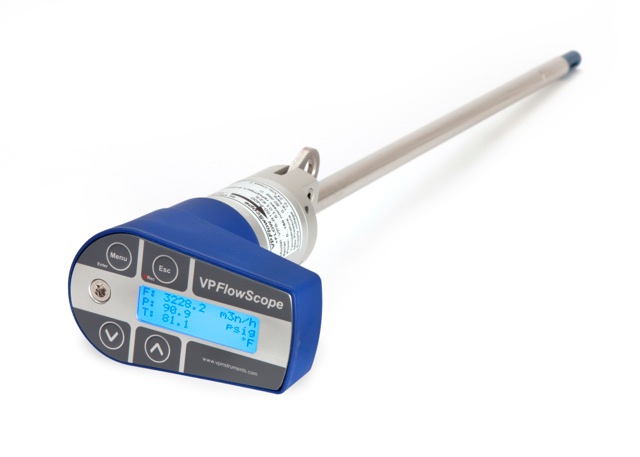 |
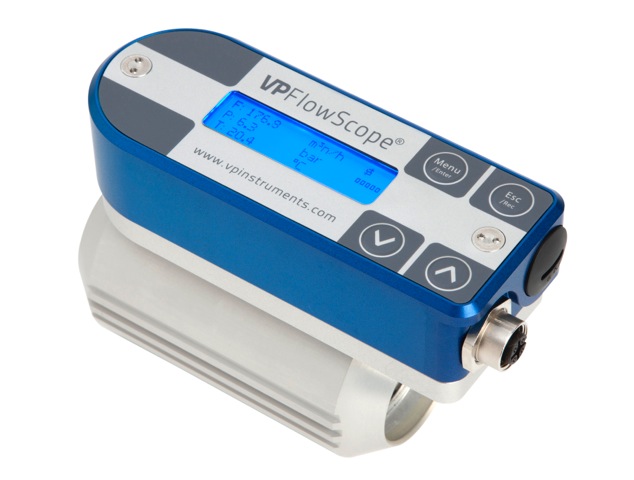 |
VPFlowScope probe with display and integrated data logger |
Flow meter designed for point of use measurement |
How important is application knowledge with flow meters?
Understanding the capabilities of the flow meter and selecting the correct installation location is very important. Below is a list of thirteen “tricks and tips” we recommend users keep in mind.
- Install in straight pipe lengths for optimal results
- Thermal mass: make sure that the air is dry, without droplets
- Differential pressure and vortex meters: be aware of limited range, leakage cannot be detected in most cases
- Mount sensors in a 2 o’ clock position, so incidental water and dust can drip off/ fall off
- Always check temperature and pressure, avoid large fluctuations when possible
- Installation in ring networks? Use a Bi–directional flow meter (VPFlowScope)
- Installation downstream of receiver (demand side) with multiple receiver/ compressors? Be aware of back-flow situations.
- In vertical lines: it might rain condensate when the air is wet. Avoid these installations when possible.
- Temperature drops below dew point: rain and snow/ ice may be present in the air flow
- Short meter runs: expect deviations up to 100% of the measured value
- Desiccant dryers may use (too much) air. And it is not always 10% of the actual flow. It’s 10% of the max capacity. Or more. Flow meters downstream of these dryers can indicate a lower value than the compressor output
- Compressors can leak internally. A low flow reading is an indication of failing non-return valves or leaky condensate drains.
How do factories evolve from no measurement to full measurement?
Normally we observe a two or three-step process. Factories will begin with installing a VPFlowScope at the header pipe after the dryer and receiver tank. This provides them with a total flow number that they can compare with compressor kW consumption.
The second step involves measuring the compressed air flow heading out to different production departments. This allows factories to start charging the painting area (for example) for their actual compressed air use – rather than allocating a cost based upon square footage or some other rule of thumb.
The third step measures point-of-use compressed air flow use. This is very valuable as it allows factories to identify and correct air leaks immediately. We just finished a project at a chewing gum factory where they installed 40 VPFlowScope In-line probes. We all know the terrible energy costs created by compressed air leaks. Establishing and monitoring a “best practice” flow, for each machine, assures a factory that the leaks, which spring up inside the machines where no-one can hear or see them, will be detected.
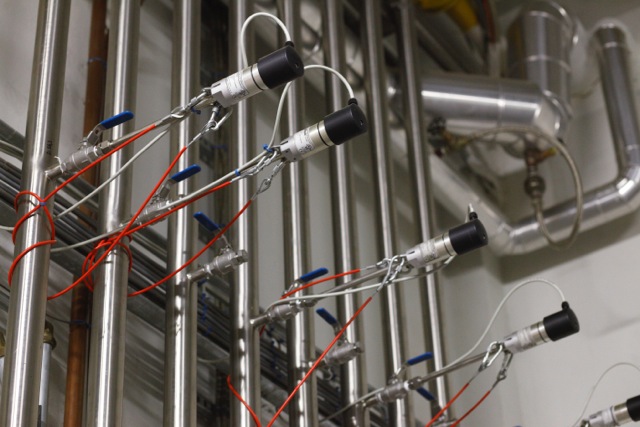
Measuring compressed air flow heading to different production areas
This ties into visualizing the system on your computer right?
Absolutely. Last year we launched VPVision to make permanent monitoring of multiple sensors easy and intuitive. When a user installs multiple sensors, in a compressed air system, the challenge is to make permanent data logging and monitoring available on the desktop computer or the portable tablet. VPVision is installed on a web technology-based mini server so data is safely kept within the factory’s premises. Data can be accessed within the factories network using a standard browser. The user can connect power meters, flow meters, dew point sensors and virtually and 4.20 mA based sensor to VPVision.
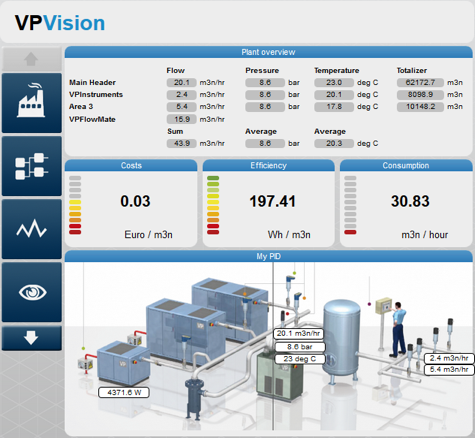 |
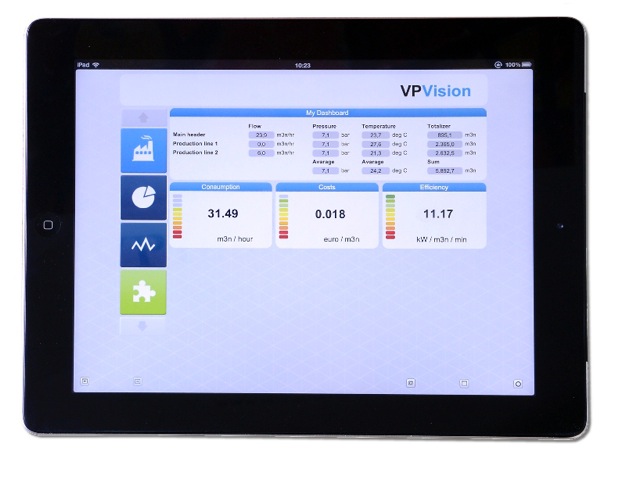 |
VPVision allows users to visualize flow, pressure, power, temperature and dewpoint data from the compressed air system on computers or tablet devices |
|
Is the compressed air industry readily adopting these new technologies?
The response has been tremendous from air compressor OEM’s, air compressor sales and service companies, and independent auditors. We have established a sales and application engineering office in Ohio to support the demand in the U.S. A company in Scandinavia, specializing in compressed air leak management, uses our flow meters in their daily leak audits and also as part of the permanently installed leak maintenance solution for their clients. Coupled with VPVision, they have created a successful business, nationwide, monitoring and managing compressed air leaks for their industrial clients.
Thank you for your insights.
For more information please contact Pascal van Putten, Chief Executive Officer, VPInstruments, or visit www.vpinstruments.com.
To read more Instrumentation Technology articles, visit www.airbestpractices.com/technology/instrumentation.




